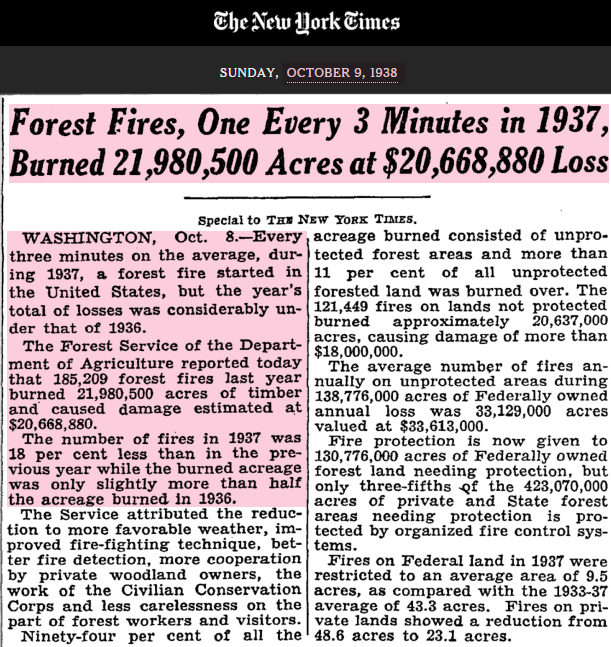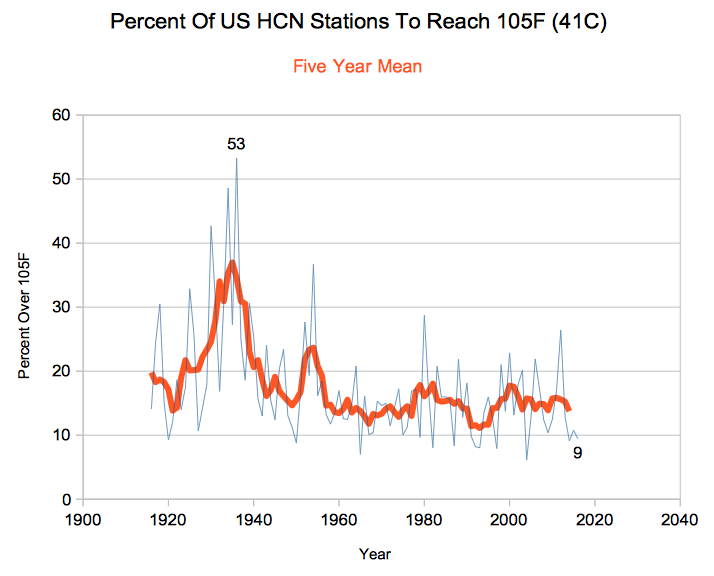This was a post I made in 2016, so some of the data are out of date.
Hot Times in the Old Town
Speaking of forest fires:
The 1930s were the banner years for forest fires. In 1937, there was one forest fire every three minutes per the NY Times.
But in 1910, a few years after the Forest Service was formed and not on the above graph, "a devastating series of forest fires swept over Idaho, Montana, and Washington, culminating on August 20–21 in what is known as the "Big Blowup." Coming only five years after the U.S. Forest Service’s establishment, this seminal event made a deep and lasting impact on the agency. ... [T]he young agency was undermanned, underfunded, and underprepared for what was to come. ... On August 20 hurricane-force winds swept through the region and fanned embers and low flames back to life all across the Northern Rockies. There was no stopping or containing the fire; one could only hope to avoid it. Trains raced to evacuate towns just ahead of the flames."
Thus began the Forest Service's Smokey the Bear campaign to prevent forest fires. Unlike most federal programs, it seems to have been successful and involved among other things a program of "controlled burns" in Forest Service lands to clear out inflammable underbrush. About 30 years ago, TOF read an article about the end of the controlled burn program because it was non-environmental: Nature should be allowed to take its course, even if that meant occasional wildfires. Hey, it's Nature!
Lo and Behold! As the underbrush and deadwood once more accumulated, the number of burned acres began to increase slightly, starting roughly ten years ago.
Flood and Mud
Fires were not the only thing going on.
ALL EASTERN AMERICA UNDER FLOOD WATERS
Terrible Duststorm Rages In West
PRESIDENT SIGNS
APPEAL AS
CAPITOL FLOODED.
100 CITIES AND 14 STATES AFFECTED.
NEW YORK. Thursday.
A quarter of the area of the United States wasunder flood waters today. It is a disaster rankingwith the worst calamities from natural causes thathave occurred in the history of the nation. Propertydamage is so great that it is almost incalculable. Lossof life may exceed 1000 for already 160 fatalities areknown and 40 people are missing.As Eastern American States became almostcovered with water, terrible dust-storms raged acrossthe central and western States, tearing the crops outby the roots and laying waste thousands of squarestorms, it rained mud.miles of country. Where the dust struck snow
Just in case you've been getting a-skeered by weather coverage lately.An extraordinarily dramatictouch was given to the Presi-dent's appeal to the nation forRed Cross fund for, even as hesigned the proclamation, thous-ands of Works Progress Admin-istration workers were strug-gling desperately to erect bul-warks against the waters of thePotomac River which rapidlyare approaching within a fewsquares of White House itself.
Hot Enough Yet?
Speaking of heat waves, in 1936 a heat wave caused 12,183 deaths in the US, the NY Times reported (July 7, 1936)The Chicago Tribune reported a week later (July 14, 1936) that hundreds had died in Detroit from the heat wave and that Chicago itself was also baking.Meanwhile, over in Ohio, the Chillicothe Constitution-Tribune in Ohio (July 25, 1936) tells us:
CROP CRISIS WORSE,with a sub-head that
HEAT RISING TO 119°
31 CITIES ARE OVER 100°Ach, du Lieber! TOF hears you ask, How many days went over 105°F?
Hard to say, but here is the graph of the percentage of US HCN temperature stations that hit that level sometime during the year:
So the 1930s peaked pretty dang hot compared to today's less extreme climate. Of course, Alert Reader will note that there will always be a few weather stations hitting the 105 point, roughly 15% of them.
The 1930s also featured worries about global warming
Warming Arctic Climate Melting Glaciers Faster, Raising Ocean Level, Scientist Says
“A mysterious warming of the climate is slowly manifesting itself in the Arctic, engendering a "serious international problem," Dr. Hans Ahlmann, noted Swedish geophysicist, said today.
– New York Times, May 30, 1937
So, the world rallied and did nothing and before you could say Jack Robinson, the Times was reporting:
“After a week of discussions on the causes of climate change, an assembly of specialists from several continents seems to have reached unanimous agreement on only one point: it is getting colder.”
– New York Times, Jan. 30, 1961
And just to emphasize the everything old is new again theme, 1938 was
also the year Hilaire Belloc wrote his warming that Islam, though then
quiescent could easily revive and threaten once more the cities of the West.
The common root to all this is short term memory.
"[M]en are always powerfully affected by the immediate past:
one might say that they are blinded by it." -- Hilaire Belloc





It's a pity that the top graph ended in 2008. It would have been interesting to see how later years would have looked in comparison.
ReplyDeleteTo me it feels as if there were a few really hot summers, which not surprisingly caused more fires than usual.
Here you can find a chart over MEAN temperatures: https://www.statista.com/statistics/500472/annual-average-temperature-in-the-us/ (couldn't post a picture)
The years in question are hardly noticable in that statistics.
Best regards
It's not often you find a person who thinks the 1930s were so wonderful, and that it's OK to duplicate the conditions we faced from weather back then on a regular basis.
ReplyDeleteWhy do you suppose it's "okay" simply because it's what happened. Hume said you can't get an ought from an is.
DeleteThe 1930s were not "wonderful," or at least, not uniformly wonderful. Like all large masses of mankind, there were good aspects (to our way of thinking) and bad aspects (again, to our way of thinking.)
The Dust Bowl was due to private-sector incompetence, not weather. The Ukrainian "Famine" was due to government malice, not weather. The Great Depression was due to government and private-sector incompetence.
DeleteWhy, what conditions faced from weather were you thinking of?